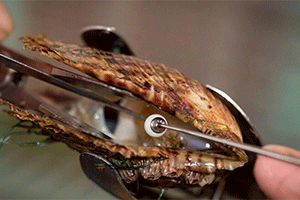Oysters with Pearls
No Grit - No Pearl
You might have heard about the mythical "grain of sand" which will grow into a beautiful shiny PEARL...The popular belief that a PEARL is formed as a result of a grain of sand entering a shell is false. Sorry!
Pearls are a product of living shelled creatures called mollusks that live in saltwater seas and oceans or freshwater lakes and rivers all over the world. These mollusks live at the bottom of seas and lakes in the sand, sand is their environment, and the sand doesn't really bother them. The pearls are formed when an intruder/irritant (foreign material, usually such as a bit of coral, sharp object, or parasite) accidentally gets into the soft tissue of a mollusk and cannot be expelled. As a defense mechanism, to reduce irritation the animal produces secretions called Nacre (aka Mother of Pearl, the same secretion it uses for shell-building) that coats the irritant. Many layers of nacre coating are deposited on the irritant, some of the time can be resulting in a smooth, beautiful shiny pearl. There are about 85,000 known types of mollusk (which includes snails, slugs, and squids amongst others) but only 20 of these have the shiny shells needed to make pearls. It is these 20 remarkable, shiny shelled creatures that make pearls.
In conclusion, small organic particles sometimes get lodged in mollusks in the wild across the world. They then cover these intrusions with the same material that they use to make their shells. In the certain species of mollusk that have randomly developed shiny shells these intruders-wrapped objects are also shiny and called PEARLS...
Real Pearls
Natural & Cultured
When some people hear the words "cultured pearl" and think that means it isn't a real pearl. That's not the case at all. Natural and Cultured pearls are both real pearls, grown by the same animals. The difference is that pearl farmers have initiated the process of forming a Cultured Pearl, whereas Natural Pearls started growing by chance in the wild. Pearls that were taken from the waters in ancient times were natural. Today they are very rare and extremely expensive, and the round pearls are incredibly rare in nature. If a pearl vendor tells you it's natural, she probably means cultured and real—not a fake pearl. A cultured pearl is not an artificial or synthetic pearl. It is still produced by a pearl oyster or mollusk and by normal processes of pearl growth. The only difference between the natural pearl and the cultured variety is that the nucleus has been inserted into the oyster to enable the pearl to have a good start. It ensures a larger and more evenly shaped pearl and is produced in a shorter period of time.  To culture freshwater mussels or saltwater oysters, workers slightly open their shells, cut small slits into the mantle tissue inside both shells, and insert small pieces of live mantle tissue from another mussel into those slits or nuclei (pre-formed beads). Freshwater mussel doesn't tolerate nuclei being inserted. They form pearls around a small piece of soft tissue implanted from another mollusk. They grow slowly and the resulting unevenness is a sign that they are the genuine product of years of dedicated work by a mussel. Most saltwater cultured pearls are what we call nucleated. Pre-formed beads are inserted into an oyster which secretes many layers of nacre around the outside surface of the implant. The three main types of saltwater pearls are Akoya, South Sea, and Tahitian.
To culture freshwater mussels or saltwater oysters, workers slightly open their shells, cut small slits into the mantle tissue inside both shells, and insert small pieces of live mantle tissue from another mussel into those slits or nuclei (pre-formed beads). Freshwater mussel doesn't tolerate nuclei being inserted. They form pearls around a small piece of soft tissue implanted from another mollusk. They grow slowly and the resulting unevenness is a sign that they are the genuine product of years of dedicated work by a mussel. Most saltwater cultured pearls are what we call nucleated. Pre-formed beads are inserted into an oyster which secretes many layers of nacre around the outside surface of the implant. The three main types of saltwater pearls are Akoya, South Sea, and Tahitian.
Most cultured pearls are composed entirely of nacre, just like their natural freshwater and natural saltwater counterparts. Since 1916 pearl culturing technology has been successfully developed in Japan and shared worldwide. Eventually, cultured seawater pearls and cultured freshwater pearls became mass-produced. This makes pearl jewelry affordable and available to virtually anyone in the world.
So, are Cultured Pearls “REAL” pearls? Absolutely. Cultured Pearls are very real as they are still created by the mollusk’s natural defense mechanism like humans only introduce the irritant into the mollusk allowing the process to begin.
We learned how to farm them creating what is known as a Cultured Pearl - with the size, color, shape, and luster we want. After over one hundred years of pearl farming, we’ve become better and better at growing good quality pearls, particularly by selectively breeding the oysters and mussels that create the best pearls. This means that we’re in the lucky position of being able to grow much better quality cultured pearls at a tiny fraction of the price that would have had to be paid for their natural equivalents
Now you can see why the pearl industry has stuck to the grain of sand story...







